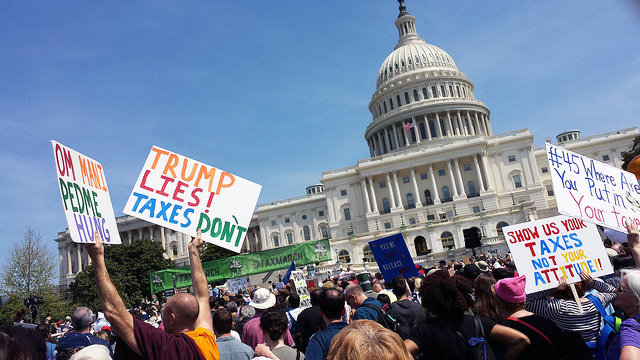
Capital demands absolute power over labor and total submission to the need for growth and profits. Capitalism is chaotic and often violent, and a quick glance at the history of Latin America or Africa reminds us that the capitalist class has no problem with dictators, provided they keep the profits flowing.
So in light of the violent and authoritarian nature of capitalism, why have advanced capitalist states tended to adopt the form called the republic: a representative democracy based on limited and distributed power, multiple parties, checks and balances, and adherence to a written constitution? Why isn’t fascism the default setting for capitalist power?
Today, we are faced with a president who lost the popular vote but claims a mandate to rule by executive order, silence opposition media, and persecute political opponents. In these circumstances, that question of political democracy in the capitalist republic takes on new urgency.
Are the institutions of the republic a guarantee of democracy or a sham?
On the one hand, the ruling class tells us that the institutions of the republic are a guarantee of democracy. On the other, self-proclaimed radicals tell us that those institutions are a sham–at best, irrelevant to real democracy; at worst, a dangerous illusion meant to keep us happy in our chains.
Both of these answers ring false. Neither captures the struggle for democracy led by workers and oppressed people within the capitalist republic, a struggle that includes victories as well as defeats and deflections. We have to account for both slavery and Reconstruction, both the NLRA and Janus, both the Trump regime and a resistance poised to turn the tide against the neo-Confederate GOP.
So if the republic is something less than the bulwark of democracy and something more than the star-spangled glove hiding the iron fist of capital, what is it–and why does it matter to the working class?
The republic as political technology
We get closer to the point if we think of the institutions of the republic as one of the great technologies of capitalism–something like the factory system and the assembly line, or information technologies and social media. Each of these technologies vastly expanded capitalist accumulation and exploitation. At the same time, however, each one created new possibilities for (and placed new demands on) working class organization.
By bringing workers together and harnessing their joint labor-power to machines, the factory system increased productivity and the profits of the capitalist class–but it also gave birth to the trade union, as workers’ common struggle brought them together despite differences of nationality, race, and language. Now, social media platforms turn our human drive for sociability into a source of profits for shareholders, colonizing our entire life as a source of surplus value–but they also generate new modes of political organization and lower the barriers to ideological work. Even as they strengthened capital, each of these technologies generated new and amplified forms of class struggle, along with new tools with which to join that struggle.
The rule of law contains intra-class struggles within a set of predictable rules.
The republic is no different. As the array of reactions to the Trump regime and its policies show, the capitalist class is not homogeneous. Different sections have divergent material interests and conflicting political strategies for pursuing them. In the face of this chaotic inner life, the institutions of the republic offer a good way of regulating internal conflict in the interest of preserving power. A multi-party state allows the regulation of factional struggles as political contests between parties. Separation of powers, backed by checks and balances, means that control of one branch of government is separate from control of the state, thereby facilitating power-sharing among different sections of the bourgeoisie. The rule of law, managed by an legally/formally independent judiciary, contains intra-class struggles within a set of predictable rules.

Just like the assembly line or Facebook, however, the republic also opened a new terrain of democratic struggle, including class struggle. That struggle has centered, historically, on the expansion of the right to vote and the attempt to turn victories won through mass mobilization into durable legal gains. Its victories include Reconstruction amendments, the 19th Amendment, the National Labor Relations Act, the New Deal reforms, the Civil Rights Act, and Supreme Court decisions like Brown v. Topeka (school integration), Roe v. Wade (reproductive freedom) and Obergefell v. Hodges (marriage equality). Those victories were possible because the forces that won them understood the importance of judicial appointments, legislative majorities, and the electoral work the produces them.
The republic is an important terrain of democratic and class struggle.
On the other side of that struggle, the current Trump-GOP agenda reads like a line-by-line reversal of those democratic gains: attacks on birthright citizenship, equal protection, collective bargaining, social welfare programs, public education, voting rights, reproductive freedom, and LGBTQ equality. That agenda, too–even more than the left’s–is the product of a decades-long electoral campaign to create Republican majorities at every level and to put the Republican Party under the most reactionary control possible.
For the immediate future, therefore, the republic is an important terrain of democratic and class struggle. The 2018 midterms are an opportunity to break the Trump-GOP stranglehold, place an obstacle to the rightward swing of our political life, and open a space within the republic for the left and progressive forces who have gathered under the banner of the resistance to the Trump regime.
The republic beyond capitalism
Thus far, I have approached the institutions of the republic as an arena of struggle–one of capitalism’s contradictions, a capitalist technology that pushes the working class to build its unity and political independence. But saying that capitalism produces its own gravediggers does not mean that we can lay down our shovels and wait for it to die in its sleep.
The republic is more than a terrain on which we fight. Like the factory, or like a social media platform, it is also an object of class struggle. This is the fundamental insight Marx reached in his analysis of the revolution in France in 1848. Inspired by the revolution of 1789, the insurgent workers of Paris demanded, and won, a republic–only to see the bourgeoisie take it over and turn it into an instrument of repression. Today, the fight for democracy within the capitalist republic is part of a larger fight over what class controls the institutions of the republic, who those institutions serve, and how they work.
That fight goes beyond “defending the republic” or preserving a pre-Trump status quo. Changing what class holds power must, and will, change how power is organized. Our work pushes beyond capitalism, toward the day when (to paraphrase Marx) the red flag of the republic of labor flies over city hall. That workers’ republic will be different from the one we know, but the struggle for democracy–at every moment, in every forum, with every resource at our disposal–is how we get there.


 Join Now
Join Now